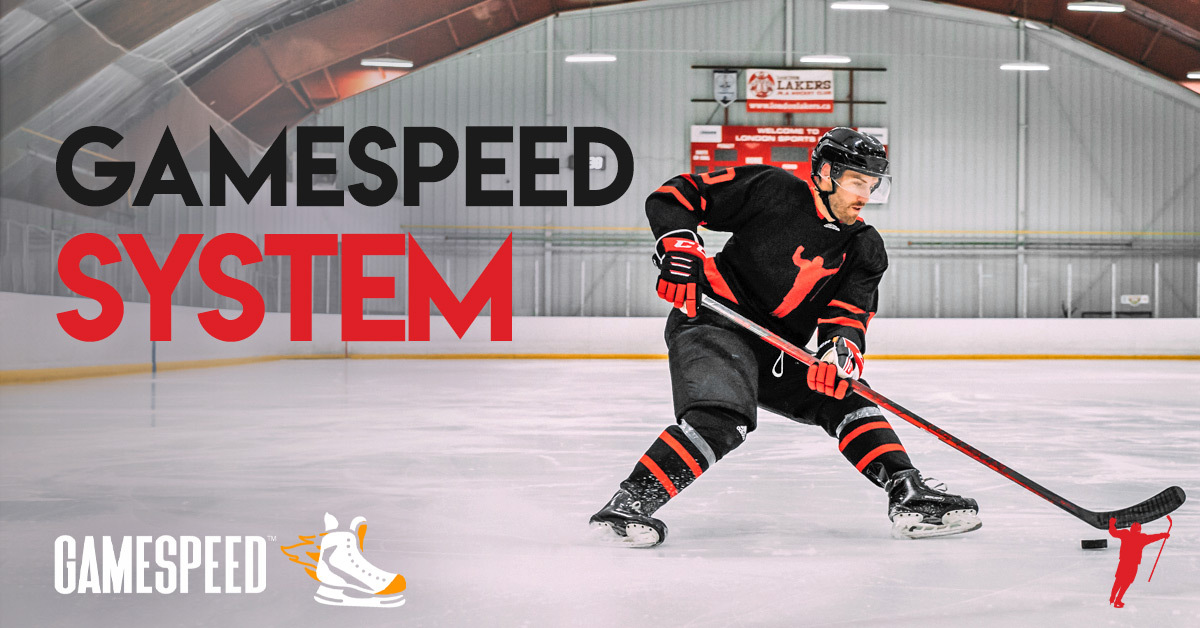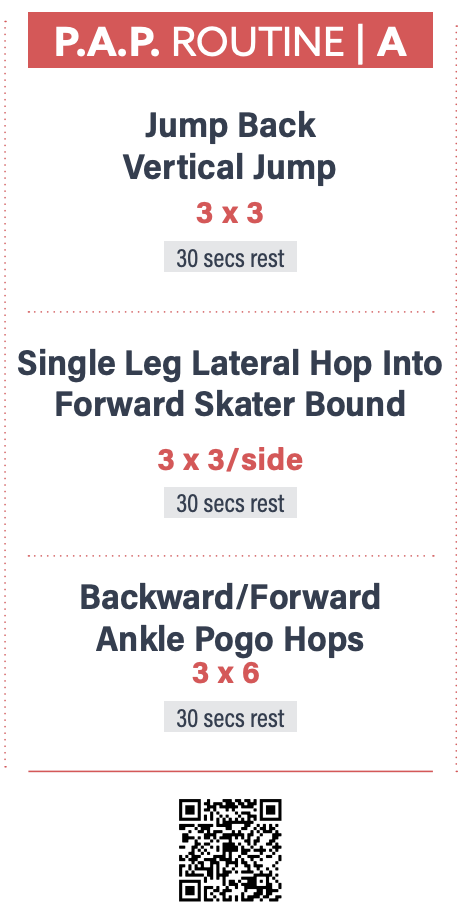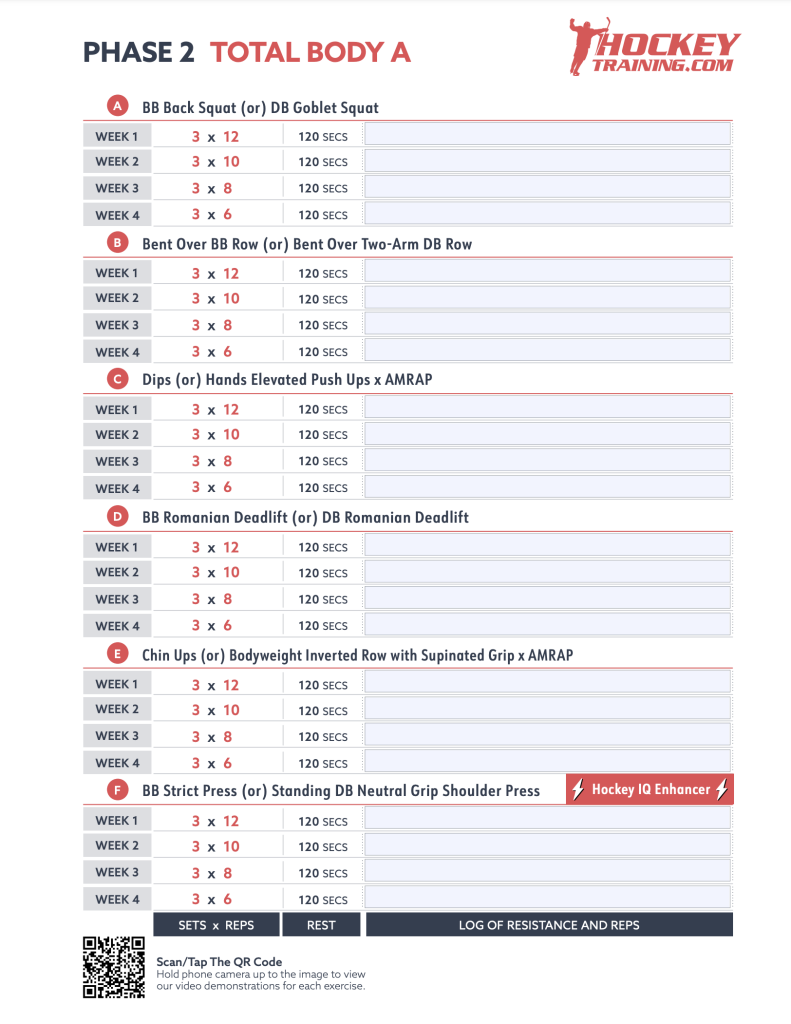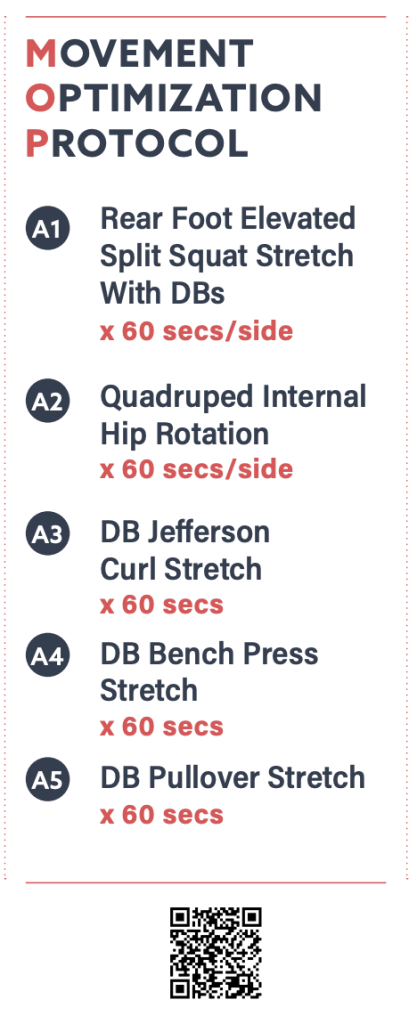I’d like to say that the theory and development of the GameSpeed™ hockey training system came purely from a place of positivity (which is mostly true), but I’d be lying to you if I left out my frustration with the hockey industry.
Every time I see a new workout posted on social media or YouTube, I immediately analyze the components of the session to identify if all of the necessary pieces are included—the things rooted in excellent scientific literature that should start and end every hockey training session.
Unfortunately, I rarely ever see the important (yet often overlooked) components such as activation work, dynamic mobility, injury resilience, functional movement patterns, and what truly transforms a “workout” into a hockey workout.
Ninety-nine percent of the time, I just see flashy stuff done for the purpose of views rather than the development of true hockey performance. This helps the coach build a following, but it doesn’t help any of their followers actually become better hockey players.
This makes my job harder, as I’m constantly needing to re-educate hockey players and parents in my content creation about what real hockey training is supposed to look like.
That’s why my articles are never just about the “how;” they always include the “why” as well, because my goal is to leave the hockey industry a better place than when I found it. I can’t think of a better way to do that than to empower you with the knowledge you need to reach your hockey dreams by avoiding the silly gimmicks you’ll inevitably encounter along the way.
As a student of the game, and someone who truly cares about changing hockey players’ lives, I always thought “new” programs should be better than they are.
This is how the idea for GameSpeed™ got started.
I wanted to create the perfect off-season hockey workout structure that any hockey player could implement to truly cover all of their bases. Whether it looked flashy or not was of no concern to me, and I certainly hope it is of no concern to you either.
The Shocking Truth
The one shocking truth your local social media celebrity doesn’t want to tell you is that if you want to improve your hockey performance, it’s going to take a rigid training sequence structure.
They want you to think that their fancy exercise or drill is a “secret” of the NHL pros, but I am here to tell you that even a great exercise done at the wrong time will yield little to no results.
So when they post a single drill and say absolutely nothing about the structure and design of the workout as a whole, they might as well have posted a cat meme, because it would have provided the same amount of value to your hockey performance.
The sequence at which you organize your training will either make or break you. You have to be serious about schedule and you have to be consistent day in and day out. Sticking to the fancy stuff and doing things based on “what you feel like that day” will never, ever work for you.
The GameSpeed™ hockey training system is unique in that it provides you with the exact workout methodology to get the best results by creating a bulletproof dryland workout sequence that’s simple to execute.
GameSpeed™ Overview
GameSpeed™ workouts are designed for off-season use only, as they will result in too much fatigue accumulation to recover from within an in-season training volume context.
The overall objective of the GameSpeed™ design is to logically sequence your training in an order and intensity that provides maximum investment from your time spent in the gym while targeting every single component of hockey performance enhancement.
With respect to focus, the “focus” is to become a better hockey player through effectively stimulating all pathways rather than one.
For example, this isn’t a “get big arms” workout, but rather a hockey workout designed to stimulate multiple pathways for progression including first-step quickness, acceleration, stride length, stride frequency, functional strength gain, dynamic mobility, explosive power development, and core stability.
This should be performed three times per week throughout the off-season. Here’s the overview of how it breaks down:
STEP #1: Performance Activation Potentiator (PAP)
A hockey-specific PAP routine is performed after your warm-up but before your workout, and it consists of a series of multi-directional explosive movements to improve all-around skating speed and activate your nervous system pre-workout for more effective fiber recruitment during your main session.
This is performed by selecting three multi-directional power-based exercises and executing three sets of each with moderate to low reps to allow for maximum explosive speed.
Benefits: Maximize explosive speed, acceleration, stride power, and first-step quickness.
STEP #2: Hockey IQ Enhancers
It is impossible to perform at your best until your Hockey IQ is just as dialed-in as your physical abilities. This is why it is imperative that you perform a select set of “tip of the spear” hockey-specific drills within certain rest periods of your functional strength training organization so that you can train your body to be patient with the puck, keep your head up, and execute flawless technique even in high-pressure situations.
This is performed by doing your complete functional resistance training hockey workout but including hockey-specific skill work for edge work and/or puck handling during your rest periods at the end of the workout.
Benefits: Gain “hockey strength” in your shot power and stay strong on the puck while improving on-ice, skill-specific (automatic nervous system patterns) performance output.
STEP #3: Movement Optimization Protocols (MOP)
If you’re not finishing your workouts with a MOP routine this off-season, then you’re going to be behind everyone else who did. This “loaded stretching” sequence is the only routine in existence that will improve explosive speed, agility, mobility, fast-twitch fiber recruitment capacity, and injury resilience all in one “finisher” circuit.
This is performed by executing a five-exercise series of loaded mobility movements for 60–90 secs per stretch hold to unlock and stabilize all joint structures.
Benefits: Optimize agility, mobility, stride frequency, fast twitch muscle fiber recruitment, fast twitch muscle fiber work capacity and reverse structural dysfunction, and improve injury resilience.
GameSpeed™ Example Workout
Below is an example workout taken from Phase 2 of our Off-Season Domination ‘22 full gym program. However, the program also has home gym and bodyweight-only variations as well.
Performance Activation Potentiator
A: Jump Back Vertical Jump: 3 x 3 [30 secs rest]
B: Single Leg Lateral Hop Into Forward Skater Bound: 3 x 3/leg [30 secs rest]
C: Backward/Forward Ankle Pogo Hops: 3 x 5 [30 secs rest]
*Perform the exercises in a straight-set fashion and not in a circuit. Rest 30 seconds between sets and repeat for three total rounds.
Functional Hockey Workout + Hockey IQ Enhancer Drill
*Note: this total body workout is from early in the off-season as we build strength and balance out any muscle imbalances from the season. As we get to the later phases you will see the workouts get more hockey-specific.
A: BB Back Squat: 3 x 12 [120 secs rest]
B: Bent Over Two-Arm DB Row: 3 x 12 [120 secs rest]
C: Hands Elevated Push Ups: AMRAP [120 secs rest]
D: BB Romanian Deadlift: 3 x 12 [120 secs rest]
E: Chin Ups: 3 x 12 [120 secs rest]
F: Standing DB Neutral Grip Shoulder Press [120 secs rest]
*Perform provided puck handling/edge work drills during the rest period of exercise “F” to act as your Hockey IQ Enhancer.
Movement Optimization Protocol
A1: Rear Foot Elevated Split Squat Stretch With DBs x 60 secs/side
A2: Quadruped Internal Hip Rotation x 60 secs/side
A3: DB Jefferson Curl Stretch x 60 secs
A4: DB Bench Press Stretch x 60 secs
A5: DB Pullover Stretch x 60 secs
*Perform the exercises in a circuit. Hold each movement for 60 seconds, rest 30 seconds between movements, and perform the whole circuit only one time (i.e. only perform each exercise once and then you’re done).
Why the Traditional Workout Model Doesn’t Work
The above GameSpeed™ formula is the combination of many thousands of hockey players’ worth of coaching experience and dedicated hours of keeping up to date on the most cutting edge, sport-specific training methods.
As you can see, it strays far from “the norm.” But if you want to perform unlike the norm, then you have to train unlike the norm.
The “traditional approach” is OK, and you’ll still get some sort of result (which is why so many stay stuck in their ways and don’t make it too far). But it also burns away a totally immeasurable amount of time getting you “fit” but not necessarily “fit for hockey.”
Put another way, in a traditional one-hour session, you’re likely spending 30% of your time doing things that aren’t driving your hockey performance forward in the most efficient and cutting edge way (and honestly, that’s being generous).
With this math (where I’m certainly giving you the benefit of the doubt), I want you to think about it: this means after one month of training, an entire week was dedicated to just your “general” fitness.
Even worse, if you do this for a year, you have spent up to four months of your dryland training doing stuff that might make you look better in the mirror but certainly won’t help you skate faster or score more goals.
Don’t get me wrong: the traditional structure can still have some merit for beginners and recreational players, but if you’re serious about becoming a better player and you’re still doing this type of approach (or even worse, defending this type of approach), then you will be a victim of “hindsight is 20/20” down the road when you realize what a difference it would have made to train on an NHL-caliber system.
The best hockey programs are the ones that have an integrated approach where it all blends in together, and each component of the workout is clearly working towards something significant and meaningful for hockey performance.
The above workout is only one example of a full six-phase program where you will be doing only the most hockey-specific training on the planet multiple times per week all off-season long.
Imagine what you could accomplish!
If you’re in, join the team here and I’ll see you for your first coaching call.
Final Thoughts
I hope I was able to shed some light today on how hockey players should be training for optimal results and what type of template they should be using for their workout programming.
Remember: this article was about hockey workouts and not a program.
Biology responds to stimuli over time, and not within specific windows of time. Meaning, it’s not a workout that is going to get you results, because only a complete program can do that.
This is why I can’t recommend enough that hockey athletes get access to the Off-Season Domination ‘22 program here at Hockey Training.
It utilizes the GameSpeed™ formula all off-season long and covers your bases more than any other off-season program currently available. I know this without a shred of uncertainty, because it uses the most up-to-date scientific literature in existence.
Learn more here and let’s go!






